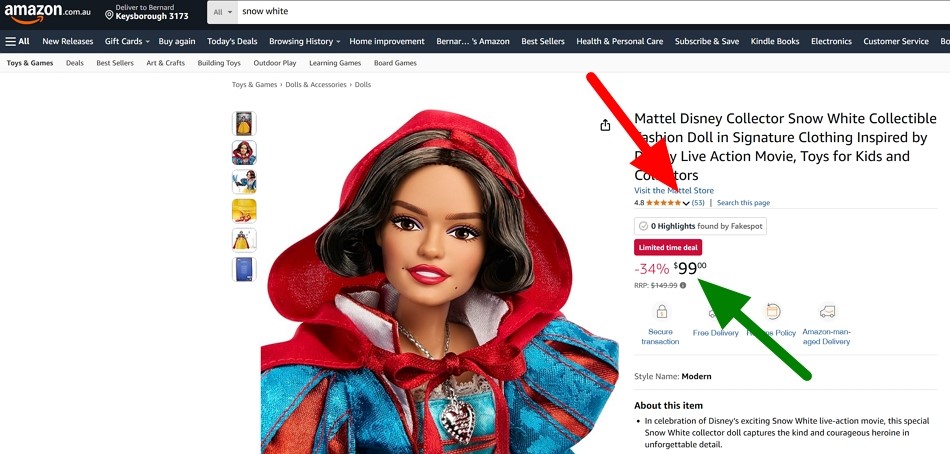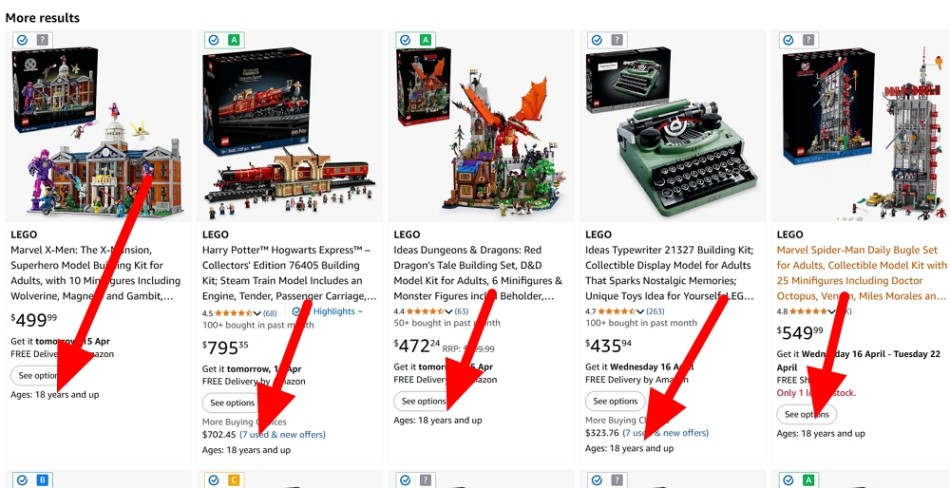The toy retail market has always been challenging. Because trends shift rapidly, retailers must have sharp insights to succeed, as the trend graph below shows.

It did go down a bit recently, but it's expected to go up this year.
I was talking to a major buyer of toys in a large retail store, and here is his advice based on his experience. It's useful as it shares practical lessons from someone on the front line. Could you consider implementing his strategies to boost your shop's sales?
Lesson 1: Beware the Risks of Media Hype
Product hype, with media hype, can present a financial risk if the hype fails and consumer excitement does not translate into sales for some reason. A recent example that sparked this conversation involved the recent Disney Snow White dolls released alongside the film. Shortly after the film's release, we can see deep discounts on these dolls, which are widely appearing across major retailers. Look at the green arrow; you can see it's already at a 34% discount.

This rapid price reduction suggests that initial inventory orders have overestimated consumer demand.
Interestingly, this apparent overstock situation doesn't stem from dissatisfaction with the product. Early consumer feedback often highlighted the dolls' quality and design. Could you look at the red arrow highlighting what consumers thought of the product? 4.8 out of 5 is good. Instead, the poor sales appear directly linked to the film's disappointing reception. It shows that a well-made product can falter if the media it depends on underperforms.
Actionable Takeaway
Diversify inventory
Do not over-invest in recent trend-based items. Could you look at your good sellers and analyse your POS data relentlessly?
Strategic Ordering
Start with a small order for high-risk, licensed products. Reordering successful items is often less costly than discounting to clear unwanted stock at a loss.
Leverage Local Insight
Monitor your customer inquiries. Local demand is often a more reliable predictor than national forecasts. Again, your POS system is critical for tracking these trends.
Lesson 2: Look at LEGO
Contrast Disney's unpredictability with consistently high-performing brands like LEGO. LEGO always seems to sell; ask yourself why.
We thought it was because LEGO has extensive appeal. It is not just that while children are a core market, the brand also cultivates a massive and lucrative adult base. You can see this if you look at LEGO's tactics: with its limited editions and controlled releases, they do not just sell toys.
Actionable Takeaway
While securing LEGO exclusives might be difficult, focus on creating unique value propositions.
Target High-Value Niches
Consider courting adults as this 'kidult' market often has higher disposable income.
Create In-Store Exclusivity
Try to be unique in some way.
Bundles
Pair a popular toy with a related item, e.g. a book, craft kits, etc.
Strategic Promotions
Run limited-time, store-specific offers. I had a customer who brought some LEGO limited edition products based on space travel; they generated a lot of interest.

Look at the red arrows; they are not even targeted at kids. While you are at it, look at the price points.
Lesson 3: Target the Grandparent Market
What you can see in the toy market today is the growing financial influence of grandparents in toy purchasing. Today, they have fewer budget constraints than parents facing the rapidly increasing cost of living pressures. Grandparents today have significant spending power and a strong desire to treat their grandchildren. It makes them a crucial, high-value customer segment for independent toy retailers.
These grandparents prioritise durability, educational value, nostalgia, or finding that special 'wow' gift. They often buy from their memories, and your sales approach must reflect this.
Actionable Takeaway
Optimise your store and service model to get this lucrative demographic.
Accessible Store Layout
Make the physical shopping experience easy and pleasant for older customers.
Gift-Centric Approach
Offer attractive gift wrapping, create pre-made gift suggestions or bundles, and display items clearly as potential high-quality gifts.
Lesson 4: Fewer Kids, Fewer Hand-me-downs
There is a broad social trend now with our declining birth rates, which directly impacts the toy market.
Smaller families often mean fewer "hand-me-downs." Big Brother no longer has a little brother who can get his toys, which increases the need for more new toy purchases per child. Also, the budget per child has increased with fewer children. People buy fewer toys overall but spend more on them.
The market is shifting from quantity towards quality.
Actionable Takeaway
Prioritise well-made brand toys
Make this a key selling point in displays, signage, and staff interactions.
Justify Price Points
Do not shy away from higher prices for superior products.
Lesson 5: Educational Toys
Despite economic pressures and shifting trends, the demand for educational toys remains consistently strong. Parents seek developmental advantages, and grandparents favour toys offering substance beyond fleeting entertainment. It resonates powerfully across key customer segments.
Educational value is a potent, non-negotiable selling point that cuts through market noise. It aligns perfectly with the purchasing motivations of parents and, critically, the influential grandparent segment.
Do not forget educational toys.
Layout
Maintain a robust, diverse selection of science, arts and crafts, problem-solving, literacy, and imaginative play that builds cognitive or social skills. Use clear signage and shelf talkers to show educational aspects. Make it effortless for customers to find toys that teach.
Train for Authority
Could you make sure that your staff can confidently articulate specific educational benefits?
Conclusion: Thriving with Today's Independent Toy Retail Trends
The toy market presents undeniable challenges: unpredictable licensed products (Snow White example), the need to compete with giants (like LEGO, by adapting their strategies), understanding key demographics (grandparents), adapting to societal shifts (value focus), and meeting persistent demands (educational play).
Success requires decisive action. As independent retailers, your agility is your advantage. React faster than chains, curate stock based on your customer data, build genuine relationships (especially with high-value grandparents) and deliver outstanding value through quality and expertise.
Leverage your POS data to rigorously track sales and customer preferences. Understand these market dynamics. Reduce the hype risks, broad appeal tactics, key customer segments, the value shift, and educational demand. Make strategic inventory, marketing, and store experience decisions. Focus relentlessly on what works for your business to survive and thrive.
What's Your Next Step? Which of these lessons will you implement first in your store? Share your biggest challenge or success story related to these trends in the comments below!
Written by:

Bernard Zimmermann is the founding director at POS Solutions, a leading point-of-sale system company with 45 years of industry experience. He consults to various organisations, from small businesses to large retailers and government institutions. Bernard is passionate about helping companies optimise their operations through innovative POS technology and enabling seamless customer experiences through effective software solutions.



